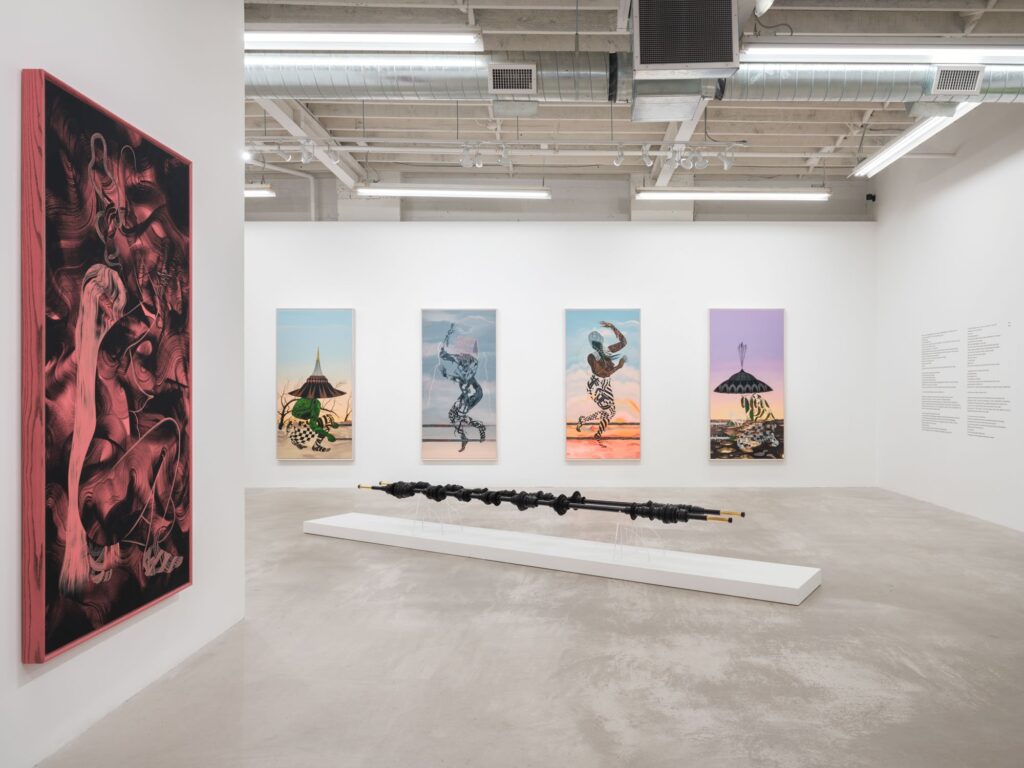THE PACE AND RHYTHM OF TIME, FLOATING / ANG TULIN AT KUMPAS NG ORAS, LUMULUTANG
MARIGOLD SANTOS
Patel Brown Gallery, Toronto, ON
June 22-July 29, 2023
REVIEW BY NAWANG TSOMO KINKAR

Upon entering Montreal-based artist Marigold Santos’s exhibition, The Pace and Rhythm of Time, Floating / Ang Tulin At Kumpas Ng Oras, Lumulutang, an exquisitely carved pair of wooden black poles hover above the ground. Traditionally made out of bamboo sticks, the poles represent a Filipino folk dance called tinikling in which two people tap and slide the sticks together and against the ground, while dancers gracefully maneuver between them. These ritual objects invoke the ancestral movement intrinsic to Santos’s practice. They activate the gallery space, setting up the stage for a performance requiring vivid imaginings, in part by the viewer.
Throughout the exhibition, Santos features the mythic figure of the Asuang, described in her artist statement as, “a medicine-woman of pre-colonial Philippines who was demonized by the Spanish missionization project in order to subdue her power.” In the first central series of paintings, shroud tinikling (2023), the Asuangs are pictured dancing, their bodies entwined with lace and weavings. Poetic ruminations on dreams and memories written on the gallery walls in both Tagalog and English are coupled with an audio of faint tapping of sticks from another room, bringing my awareness to the sonic and lyrical elements of the performance in the paintings before me.
Drawing from childhood memories, Filipinx mythology, and her immigration to Canada, Santos contemplates the complicated position of living in between places.
As I witness the lavish moments of supernatural dance in each of the four paintings, the negative wall space between each canvas that makes up shroud tinikling begins to dissolve, uniting the four works into one mesmerizing scene that restores the Asuangs’ agency by fueling their identities as healers and caregivers.
Drawing from childhood memories, Filipinx mythology, and her immigration to Canada, Santos contemplates the complicated position of living in between places, particularly the precarious work of unlearning colonial subjugation of Indigenous Filipinx culture. In the exhibition essay entitled, “At The Edge of Not Yet and No Longer,” Excel Garay and Marissa Largo call this space the “dance of the diaspora,” alluding to not only the dance taking place in the paintings but also to the act of departure and arrival associated with migration—a journey filled with sacrifice and hope, familiar to many Filipina women and diasporic subjects.

In her efforts to illuminate the Asuang’s role as a healer, the works themselves emerge from a practice of care, especially as the artist enters a new era of motherhood. To approach Santos’s work through the lens of diasporic condition is a promising first step, but to read the paintings through the specific terrain of mothering in diaspora, is to see the artist fully embark on the question pressing women everywhere: can we ever be prepared for motherhood?
Can we ever be prepared for motherhood?
In the second central series of paintings in the exhibition, shroud envisioning (2023), the Asuangs are rendered unrecognizable by the large brushstrokes that fill up the canvases. Garay and Largo attribute this stylistic abstraction to the invisible labour of care often carried by women, reminding me of American writer Angela Garbes, who in her 2018 book, Essential Labour: Mothering as Social Change, exposes how insidiously the systems around us undervalue mothers and the processes of care work integral to imagining equitable and collective futures.
Reflecting on mothering as a communal act in her The New Yorker article, American cultural critic Jia Tolentino writes about her daughter, “Maybe I… should write about caregiving, how I can only care for her because I’m being cared for, how we have to make of ourselves and our situations a soft place for others to land.”
With feet never firmly planted on the ground, Santos’s dancing Asuangs conjure possibilities for abundance despite their fragmented histories. Summoned by the stories that we inherit or pass down, these voices, full of life, carry us forward, making us whole, encouraging us to float on, and to create soft landings along the way.
Nawang Tsomo Kinkar is an arts worker and writer based in New York and Toronto. She holds an MA in photography studies from Toronto Metropolitan University and a BA in art history from the University of Toronto.

